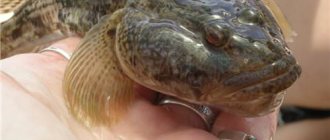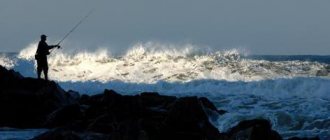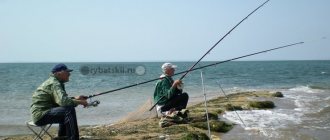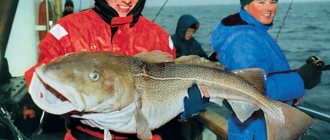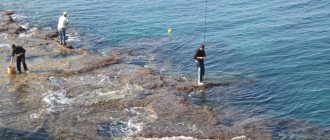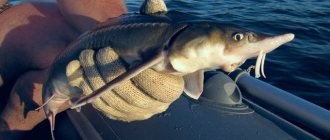Fishing places
Catching a goby
Of course, where to catch a goby depends on the body of water where the fishing is done. On the Sea of Azov, goby fishing is the most popular activity. But the whole point is that it is in Azov that the density of gobies is very high. In this sea there are about 20 varieties of goby alone. Therefore, goby catches in the Sea of Azov are very good if you know how to catch goby correctly.
Sea of Azov
Depending on the weather, the goby moves either closer or further from the shore. And this dependence lies in the fact that when the sea is rough, the goby tries to go further out to sea so as not to be thrown ashore. Also, the goby moves away from the shore on hot sunny days. When the sea is calm and the sun is not hot, the goby can accumulate in large quantities near the shore, then catching it will be very successful even in the coastal zone.
The best way to catch gobies is from a small inflatable boat. Having sailed about 20 meters from the shore, begin to fish the area. The goby is a bottom-dwelling fish, so the bait must be brought to the very bottom, playing with it, tapping on the bottom and lifting it above the bottom to attract the goby.
Having fished an area, you can move to another, depending on the result of fishing, continue fishing at the same depth or move further from the shore. Instead of a boat, you can use an air mattress. If you don’t have a boat, then you can quite successfully catch gobies from piers, breakwaters, embankments or steep cliffs.
Black Sea
Goby fishing in the Black Sea is quite popular; you can catch very large gobies there. For example, the maximum size of the martin goby caught by fishermen in the Black Sea was very impressive. The length of the bull was about half a meter, and it weighed 1.2 kg. Not bad for a bull, isn't it? An inexperienced fisherman can easily get scared when he sees such a huge goby, similar to an underwater dragon, on a hook.
Remember one rule for catching goby in the Black Sea. The goby always stays near the stones. Therefore, no matter how you catch a goby, from a boat or from the shore, always look for it in rocky areas. Only the sandstone goby stays on the border of the rocky and sandy bottom, which is why it was named so.
Rivers
Goby fishing on the Volga or Dnieper is carried out at a decent depth of about 5 meters or more. The river goby loves depth, sandy or rocky bottoms, in which it makes shelter and digs holes. Not averse to hiding in snags or other similar shelters. It constantly stays near the bottom and is always hungry, so catching it almost always ends in success.
On rivers, it is best to catch goby from a boat, because the fishing depth is quite large and you have to move quite often in search of a new promising fishing spot. If you don't know exactly where the goby might be, use the boats of other fishermen as a guide. Where there are a large number of boats with anglers hunting for bulls, you can also successfully catch them. Typically, goby bites follow after the first cast of the tackle, so if there are no bites for a long time, move around the reservoir in search of the goby.
Goby fishing is very active near sunken ships. Under such artificial shelters you can find huge colonies of goby and bites in such places will follow literally a few seconds after casting. You can catch goby on the river and from piers, embankments and various objects going deep into the river.
Goby's favorite places
This is a coastal zone with large scatterings of stones and thickets of grass. Here, under stones or in thickets of grass, he hides. The goby does not move over large areas, but lives in certain places, trying not to leave them.
The goby has a good appetite and feeds on almost everything that swims or crawls in the Sea of Azov, unless, of course, it can handle it. For the winter, it leaves its favorite places and moves to the depths.
From March to August, the goby spawns. The condition for the start of spawning is the water temperature not lower than +12 degrees. For spawning, the male finds a suitable place and builds a nest. After this, he “invites” several females to his nest, who lay eggs there. Subsequently, the male guards the laid eggs and, if necessary, ventilates the space around them, supplying the eggs with fresh water. This happens until the goby fry hatch from the eggs.
Fishing time
Goby fishing lasts all year round, both in summer and winter, but in winter the goby moves deeper into the sea, where the water temperature is more stable. After winter, the goby again comes closer to the shore and already in March it can be caught in the coastal zone.
The best period for catching bullheads is autumn. In autumn, the goby feeds with particular activity, preparing for winter, so fishermen's catches at this time of year are much larger. The best time to catch a goby is in the morning. It’s best to start catching a bull just before dawn, and when it starts to get light the bites of the bull will be very frequent and incredibly greedy. During the day, the goby's bite noticeably weakens and the goby's activity returns in the evening.
By the way, goby fishing is quite successful at night, so if you can’t sleep, you can easily take your gear and go fishing for goby at night. Fishing for gobies in the sea in the coastal zone lasts from April to November, after which the goby goes deeper, further into the sea.
Fishing technique and tactics
The main fishing technique is standard wiring:
- first they throw the tackle;
- then slowly pull it up (the line should be taut);
- when a bite occurs, you need to give a little slack;
- after this, it is necessary to carry out cutting.
- The bite occurs when the fishing line is loosened.
poklevok.net
Local residents love to catch goby, but besides the locals, there are also plenty of goby lovers among vacationers. The result almost always exceeds expectations. Local residents always have dried goby in stock, but vacationers, literally in 20 days of their vacation, will not only eat their fill of this delicious fish, but also dry enough of it and take it with them to show off to their friends and treat them to Azov goby. Even a novice angler can catch this fish from a boat, so in addition to hygiene products, the choice of which is simply huge, https://dska.com.ua/katalog/cholovicha-kosmetyka_kosmetyka/, you should definitely take fishing gear on vacation. The goby can also be caught from the shore, as it comes very close and hides, crawling under stones in the grass. He practically never leaves his usual habitat. The goby has an excellent appetite and can eat almost everything in the sea. In winter it goes into the depths from its places.
As a rule, in March, after the sea temperature rises to +12 degrees, the goby begins spawning. Having found a suitable point, the male goby begins building a nest and invites females to it. The eggs laid by the females are guarded by the male. It provides ventilation, which allows a fresh atmosphere to have constant access to the eggs. And so, it takes care of the eggs until the little one appears.
In the Sea of Azov there is a sandpiper goby, a tsutsik goby, a grass goby, a gorpych goby and a bull goby. The largest goby can be found in the March goby, it can weigh more than 800 grams, and the round goby is more common in the Azov Sea.
When it’s cloudy, the goby comes to the shallows and can be caught close to the shore. When the sun is shining or the sea is rough, the goby goes into the depths and it is better to catch it from a boat, but going out to sea in a storm is dangerous and it is better to wait until it comes to shore. The place where the goby usually stands can be recognized by the large number of boats and fishermen. Locals always know where this fish lives and catch it at the same point. The bull is caught on a bottom fishing rod or “donka”, which has a 0.5 mm fishing line and its length is approximately 15 meters. Hook No. 10 is attached to the main fishing line. The weight must be attached at a distance of 20 centimeters, and after the same amount you need to attach a leash with another hook. The leash is the same length.
Many fishermen catch a goby using a chicken stomach, cutting off tiny pieces from it and putting them on hooks. In general, the goby is not picky and will bite at anything. Local residents catch a lot of bullheads and in every yard you can find dried bullheads strung on a rope.
atemifishing.ru
Baits
The goby, although a small fish, is a very voracious predator, so you need to catch it using animal bait. The bull will happily eat any meat. The most common and effective baits are:
- pieces of bull;
- mussel meat;
- shrimps;
- sea and earthworms;
- pieces of any meat;
- squid;
- chicken navels, etc.
Very often, fishermen stock up on a small amount of bait and when it runs out, they take a freshly caught goby from the cage, cut it into small pieces and put it on a hook. The goby, being a notable glutton, with great pleasure captures pieces of the goby, which until quite recently was its neighbor.
Other baits are also very good for catching bullheads - shrimp, mussels, pieces of any meat. And it is advisable to always have several different baits with you, because often the goby’s food preferences change and he bites more actively on either one or another bait.
Fishing technique
Bullheads are usually caught using wire or fly fishing. A long cast is made, after which the line is slowly, with stops and short jerks, reeled in, which for the bull imitates the movement of wounded prey. The plane tree usually attacks at the moment when the “prey” freezes.
He makes short but strong throws of 15-20 cm, but does not touch the bait, which moves faster than him. When fishing with a short rod from a boat, a waiting tactic can also be used - if the sinker touches the bottom and the line stops moving freely, then you can freeze and wait for a bite.
Fans of spinning rods can try jigging while playing with the bait. The game is that the hand constantly makes small twitching movements, the nozzle in the water trembles and makes short small jerks. For this method of fishing, only a microjig or a long vibrating tail is suitable; relatively large bulls are caught.
If opportunities allow, try different tactics, and you will definitely find one that will provide you with a catch in a particular place at a particular time.
Tackle
What kind of gear can you use to catch a bull?
In fact, gobies can be caught both with the gear everyone is used to, and in less-than-usual ways. For example, it is not necessary to use expensive and thin gear for catching a goby, so it is better to choose a cheap fishing online store where you can always buy good fishing gear at a low price and not worry that the quality of fishing will deteriorate. Goby fishing
Fishing with a line from a boat
A very popular type of catching a bull from a boat using a regular fishing line wound around a finger. One hook of size No. 10-12 is tied to the end of the fishing line and a weight is attached (you select the weight of the sinker at your discretion). Wrap the other end of the fishing line around your finger and lower the bait to the bottom.
If the density of gobies at the fishing spot is high, then simply lower the bait to the bottom and wait literally half a minute. If there are not so many bulls, then you need to twitch the bait, knocking it on the bottom, making pauses.
To catch a goby in this way, use a fishing line with a cross-section of at least 0.4 mm so that the fishing line does not cut your hand. The goby is not a shy fish, so a fishing line with a cross-section of even 1 mm will not alert it. You can use a winter fishing rod for these purposes. The principle is the same, it’s just a little more comfortable to catch. You can use several hooks with different baits on the tackle at once.
This is how most anglers catch bullheads from a boat. A very convenient and effective type of goby fishing, which allows you to catch several dozen of this fish in a short time.
Spinning
To catch gobies with a spinning rod, an ultralight class spinning rod is used. For spinning goby fishing, it is best to use a microjig, and as bait:
- silicone worms;
- silicone fish size 1.5;
- tails from twisters and vibrotails cut in half.
The technique of placing bait when catching goby is quite specific. The fact is that the goby attacks the bait only when it is no further than 20 centimeters from it. Therefore, the wiring should consist of jerks of the bait of 15-20 cm, followed by a pause of about 10 seconds. This type of wiring is more reminiscent of dragging the bait along the bottom. But playing with bait should in no case be sluggish; the bull reacts better to sudden movement of the bait. Twitch the bait with your hand and pause, reel in the line a little and again give a small tug of the rod with your hand.
Catching a goby with a spinning rod allows you to catch a fairly large area in one cast, and if there are gobies in the way of the bait, there will definitely be bites if the bait is positioned correctly.
Zakidushka and donka
The bait is very easy to make, and the efficiency of catching a bull with such tackle is very high. To make the tackle, you will only need a sinker weighing about 50 grams, a 0.5 mm fishing line and 2-4 hooks No. 10-12. The hooks are attached to the main fishing line not directly, but on twenty-centimeter leashes. The distance between the hooks is also 20 cm.
After casting the bait, you need to tighten the fishing line and hang a guard on the fishing line. The guard can be a twig, a blade of grass or a bell. You throw a hook, a board or another object that you use as a reel, on which the fishing line is wound; the hook must be stuck into the shore, and a stick or straw, literally the very top edge, is placed on the fishing line that goes into the sea above the shore. The line is in a slightly slack state. When there is a bite, the line tightens and the guard falls. This is where it’s worth cutting.
If there are no bites within 5-10 minutes after casting, pull the tackle to the shore about a meter and wait for a bite again. Carry out such a pull until the bait falls into the bull's field of vision or the tackle is completely pulled ashore. If there are no bites, cast in another place. The same principle of fishing with a donkey, with the only difference that with a donkey you will not have a reel, but a rod.
Float rod
To fish with a float rod, it is not at all necessary to use a thick fishing line, since there is no danger of cutting your hand and it is also not necessary to make long power casts. It is better to place larger hooks so that the bull does not swallow small hooks deep into the mouth, causing difficulty in removing them.
It is optimal to use several hooks on one fishing rod at once, then, even if the bait is pulled from one hook, you can wait for a second bite on the second hook.
Microjig
Her movements should be jerky, with a very short movement distance, and with pauses between leaps. The goby does not chase long distances, it attacks in short swoops, instantly moving 5–15 cm. Moreover, attacks occur at the moment when the bait freezes or moves smoothly and slowly.
Any small rubber is suitable as bait for such fishing - edible small worms, and larger worms simply cut into two or three parts, twisters Paramax 1.5, fish of one and a half sizes... Offset hooks are selected in sizes No. 8 - 12 for your type of rubber, but if the number of empty bites is large, then you need to minimize both the size of the bait and the size of the hook. Sinkers can be very different - jigs, bullet-shaped, or split-shot pellets.
Goby fishing gear
Today, the following gear can be used to catch gobies:
- spinning;
- float rod;
- snack;
- Donka.
Each tackle has its own advantages and disadvantages. There is no universal tackle. When choosing gear, it is necessary to take into account weather conditions, fishing location, time of year, etc.
Spinning
As a rule, spinning fishing is done from the shore. In this case, the fisherman can make long casts. Spinning allows you to cover most of the coastal zone. You can use the wiring technique and donk.
Rod parameters:
- the wiring should consist of very thin fishing line;
- the test should be 4–5 grams;
- length 2–2.5 meters.
The following baits can be used:
- vibrotails;
- wobblers;
- twisters.
Float rod
Catching a bull with a float rod is extremely simple. This is the most common way of catching such fish. You can fish from a boat or shore.
Recommendations:
- one fishing rod should have several sharp hooks;
- It is recommended to use large hooks;
- you can use thin or medium fishing line;
- use a light rod.
Zakidushka
This is the most effective way to catch a bull. However, so-called snags often arise. Therefore, it is necessary to stock up on spare hooks and sinkers. First of all, you need to make a special tackle.
The zakidushka consists of the following elements:
- 20 centimeter leashes;
- strong fishing line;
- sharp hooks;
- sinkers (20–40 grams).
Fishing technique:
- first they throw the load;
- then you need to pull the line;
- when biting it is necessary to give slack;
- after this, the bull is hooked.
Donka
Donka is not much different from zakidushka. The main difference is the rod. When making your own donkey, you need to take into account the fishing conditions.
Donka consists of the following components:
- rod;
- sinker;
- fishing line;
- hooks;
- reel;
- bite alarm.
Fishing technique
Catching a goby from the shore
The technique for catching a goby is as follows. The baited tackle is thrown as far as possible from the boat, or to where the last bite was. As a rule, casts are made either to the left or to the right of the boat. If cast to the right, the line is held above the water using the index finger of the right hand, and the bait is slowly pulled along the bottom with the left hand. In this case, you need to ensure that the fishing line is always taut. As soon as you feel the moment of a bite (twitching), the line should be released. It is at this moment that he takes the bait thoroughly. You should immediately make a sharp hook, after which the bull is pulled out of the water.
Thus, two bulls are caught at once. You can’t delay hooking and you shouldn’t wait for the second goby to bite, since a goby caught on the hook can lead the tackle behind rocks or into a hole and getting it out of there will be very difficult, and sometimes impossible.
Another situation may happen when the tackle gets caught, but there has not been a bite yet. Then it makes sense to leave the tackle in this position until the bite occurs. After the goby swallows the bait, it can release the tackle from the hook.
Using a boat, you can immediately catch several baits at once, scattering them around the boat in a fan. In the event of an intense bite, all that remains is to pull out the gear to check. Usually in such cases, when you check the hook, the bulls are already sitting on the hooks, and perhaps only on one hook.
What gear is optimal?
This fish is not difficult to catch and play, so the main gear for catching a goby can be almost anything, from an ultralight spinning rod to a float rod or a regular casting rod. Only heavy sea spinning rods are not recommended - this fish is too small for gear of this class.
And here's what you need to know: How to cut off small crucian carp to catch large ones
The basic principle of rigging for a bullhead is that the sinker must touch the bottom of the reservoir, and not be attached to the end of the fishing line. After the place where the sinker is attached there should be another half meter to a meter of fishing line.
Float tackle differs from goby donkey only in the presence of a float that signals a bite. Please note that when fishing using the float method, the same principle must be observed - the sinker, which means that the main part of the line with leashes and hooks must touch the bottom.
Adviсe
Gear for catching goby must be selected in accordance with the season and place of fishing. Experienced fishermen are ready to share their experience in this matter. It is believed that the most convenient way to catch a bull from a boat is with a hook. If fishing is done from the shore, it is better to give preference to a spinning rod. This gear is also chosen if there is a muddy bottom in the reservoir. For a river with shallow depth or when fishing on the seashore, you can choose a float rod.
In winter, it is best to catch a bull with a spinning rod or a fishing rod. The fish sinks deep at this time. With the help of the presented gear you can ensure a high bite. The sinkers of such gear should be quite heavy. It is preferable that their shape be round. The line should have a medium thickness.
In the spring, it is best to catch a goby using a float rod. With the arrival of warmth, the fish rise from the depths, living in coastal areas with shallow depths. In summer and autumn, a bottom tackle or a hook is perfect.
Having considered the features of goby gear, you can choose the right fishing rod for catching this predatory fish in various bodies of water. In this case, it is necessary to take into account the terrain conditions, as well as the time of year. In this case, the catch will be plentiful, and the time spent on the reservoir will leave a lot of good impressions.
Types of tackle
Tackle for catching goby on the sea or river can be very diverse. Most often, experienced fishermen use float, bottom varieties, as well as casting or spinning rods.
Specialized stores offer a wide selection of gear for bulls. For this type of fishing, a fishing rod with the simplest design is quite suitable. Its weight should be light. It is better to give preference to comfortable fishing rods. Experienced fishermen can create their own gear for catching gobies.
When choosing a fishing rod, you need to take into account the time and place of fishing. For each type of blank, it is recommended to use a fishing line with a certain cross-sectional size, as well as special hooks. The entire system should provide comfortable fishing. Subsequently, it will be possible to make gear yourself. In this case, it will be possible to take into account a number of the angler’s requirements, the peculiarities of his style of fishing out of water.
Fishing rod
Among experienced fishermen, fishing for the Azov goby is especially famous. Even the simplest types of gear are suitable for sea fishing. Often, fishermen choose the most ordinary float rod.
The form should be light in this case. To make the fishing process convenient, it is recommended to select a rod with a length of 2.5 m. In this case, a blank with a slow action is optimal. This will make it easy to fish the voracious predator out of the water.
Read Catching sabrefish
The size of the line doesn't matter much. Most often, a monofilament thread with a diameter of 0.8 mm is chosen for these purposes. However, hooks should be selected large. Otherwise, the fish swallows them completely. The float should be chosen in the shape of a pear. This ensures its good stability even in rough seas.
Experienced fishermen advise attaching two hooks to the equipment at once. In the Sea of Azov it is often possible to get two fish out of the water at once.
Making tackle for a bull with your own hands
The most effective tackle that you can make yourself for catching a bull is an elastic band. It is used for bottom fishing, and in its structure it is very similar to an ordinary bait. Its important feature is that the rubber band can be thrown only once, after which it must be adjusted again.
To make this gear, you should prepare the following elements:
- Sharp hooks with a long shank.
- Line with a diameter of 0.2 mm to 0.3 mm for leashes.
- Line with a diameter of 0.5 mm to 0.6 mm for use as a main line.
- A strong elastic band with a length of three to five meters.
- Duct tape.
- Cambric.
- Reel (for winding fishing line).
The process of making a rubber band for catching a goby is as follows:
- First, you need to wrap a small layer of adhesive tape (ordinary electrical tape can be used) on the reel to make it easier to hook the hooks when transporting the finished gear. Also, the tape can be replaced with a small piece of foam rubber or foam, which are also very suitable for this purpose.
- Next you need to wind the fishing line on the reel (about forty meters). This will be enough for fishing from the coastal zone. If casting will be done from a boat, then more fishing line should be reeled in.
- Step back forty centimeters from the end of the fishing line and make five stoppers to secure leashes and hooks. You need to tie two knots to each stop one at a distance of one centimeter from each other. There can be many different types of knots, but it is best to make a double knot.
- After this, you should tighten all the knots and make another one nearby.
- At the tip of the fishing line, tie a loop with cambric. To do this, you need to stretch the fishing line into a cambric, the length of which must be at least four centimeters. After this, make a loop.
- Tie an elastic band to this loop. If you tie an elastic band directly to the fishing line, it will quickly come undone or fray, which will threaten rapid wear of the gear. The length of the elastic band used should be from three to five meters, but it is recommended to initially install a long elastic band so that during the fitting process it can be bandaged, trimmed and adjusted. You should know that if the length of the elastic is insufficient, the weight will be pulled up all the time, which will lead to the breakage of the tackle.
- Next you need to tie the fishing line to the weight.
- Then you should make leashes with hooks. To do this, you need to tie the hooks to the fishing line and make a loop.
- Place a cambric on the shank of the hook.
- Attach the leash along with the hooks between the stoppers on the fishing line. Pull the hooks into the loop and tighten near the main fishing line. After this, the equipment is ready.
When to catch a bull
In winter, gobies are caught around the clock. This intricate fish is active both during the day and at night. Usually, at night, the goby’s bite is still quite active, but at night you can’t do without a tent, since the frost deepens significantly.
Of course, it is more convenient to catch a bull during daylight hours, since during the day it is warmer and searching for fish is more comfortable. At night you have to sit stationary, and in order to move to another hole, you also have to drag a tent with things with you.
Typically, anglers go out to catch winter goby at dawn and sit until they catch the required amount of this fish. If the goby is biting well, then you can go fishing quite successfully and pull out dozens of good specimens.
But when is it better to catch a bull during the warm season, read this article.
Fishing Features
When you come to these places for fishing, you should familiarize yourself with some fishing features that may affect the choice of gear and fishing technique. In the Sea of Azov, industrial fishing is carried out year-round, which leaves an imprint on the rules of recreational fishing. Free fishing is allowed only near populated areas. When using a watercraft, you must remember that you can move no more than 1.5 km from the shore. Fishing is prohibited in most estuaries. In some areas of the coast, fishing with amateur gear is not allowed until the end of March.
Many fishermen always gather on sand spits located some distance from the shore.
The natural location and complex bottom topography make the Sea of Azov an excellent place for fishing and family recreation. The most active bite is observed in these parts in early spring and late autumn, when relatively low water temperatures force the fish to feed intensively in order to maintain the necessary balance of forces. Fishing on this reservoir can be divided into 3 types:
- fishing from a boat;
- from the shore;
- trolling.
Fishing from a boat is also called “bottom fishing” and is practiced by most local and visiting fishermen. Fishing from the shore is called “surf” fishing. It is usually practiced among those who do not have reliable watercraft. Trolling is usually used to catch large pike perch and other predators.
The most numerous inhabitants of this reservoir are the goby, ram and pelengas. They are also among the most popular objects of recreational fishing. They can be caught not only in “wild” areas, but also within the city of Azov.
Echo sounders for shore and boat fishing
Gobies
Goby fishing in the Sea of Azov is widespread due to the unpretentiousness and large numbers of this fish. There are more than 20 species of representatives of this family in the local waters. The location of this underwater inhabitant directly depends on the prevailing weather conditions. When the wind increases and the air temperature exceeds 25 degrees, he moves a considerable distance from the coast, where he feels safer.
When the wind gusts subside and the heat subsides a little, it returns to coastal areas richer in food. It’s good if the fisherman has an inflatable boat, which will allow him to move 20–30 m from the shore, where massive concentrations of goby are usually observed. If you don’t have a watercraft, you can use long-distance casting gear and fish from the shore. Since this species leads a bottom-dwelling lifestyle, the hook and bait should lie on the bottom or be in close proximity to it.
On a note! The goby is a predatory species and reacts well to any movement, so in the absence of a bite, it is necessary to animate the bait from time to time.
This Azov fish is most active at dawn and at night. It can be caught using the following types of gear:
- feeder;
- classic donka;
- float rod;
- spinning.
On the Sea of Azov, strong winds often blow, raising high waves, so the reliability of the watercraft must be taken very seriously.
The main key to success is the constant search for schools of fish. If today gobies were caught in one area, this does not mean at all that tomorrow their biting in this place will resume.
Taran
From mid-summer until the end of September, ram is caught well in the sea. The most promising places for fishing this fish are coastal areas of estuaries overgrown with reeds. During active biting, this fish does not pay much attention to the roughness of the equipment and greedily grabs the bait offered to it. With the arrival of autumn and the cooling of the water, the ram enters the rivers, where it becomes much more difficult to catch it. To catch it, a match float tackle or feeder is usually used.
